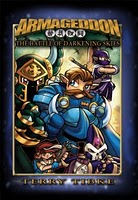4 FREE Copies of Armageddon - The Battle of Darkening Skies!
 Wednesday, January 13, 2010 at 7:39AM
Wednesday, January 13, 2010 at 7:39AM It has been a significant amount of time since I've been able to give propper respects to blogging. I, unfortunately, have a number of jobs, not the least of which is writing the second book in the Armageddon series. If I'm going to take time out to write, shouldn't I be working on an actual novel?
Despite the success its had so far, a book like The Battle of Darkening Skies should not be living such a sheltered life. There are so many people in the world that I'd like to have the opportunity to read this story, and today I've decided to do something I haven't done before.
Today I'm going to be giving away 4 signed copies of Armageddon - The Battle of Darkening Skies, absolutely FREE! Each hardcover copy will also include a small sketch of one of the Armageddon characters in The Battle of Darkening Skies -- just to make it all the more sweet!

Best of luck to everyone who plays!
Terry Tibke
http://moonshaft.deviantart.com
http://www.facebook.com/profile.php?id=1758055662&v=feed&story_fbid=107162585907#/pages/Terry-Tibke/74415538156?ref=nf
 Terry Tibke,
Terry Tibke,  armageddon,
armageddon,  book,
book,  free,
free,  signed copy,
signed copy,  sketch
sketch 
